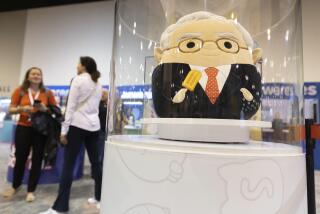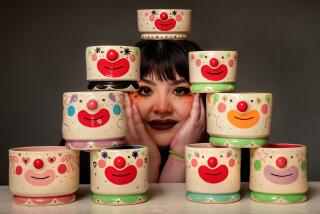Figurine maker Hagen-Renaker hopes for a miniatures resurgence

Hagen Renaker has been in business for 69 years, making ceramic animal miniatures that are loved by collectors. The company has struggled through some hard times and is hoping for a comeback.
Susan Renaker Nikas still remembers the duck that saved her parents’ ceramics business nearly 70 years ago.
The tiny bird was white and seemed to be gliding on a lake, designed on a whim by her mother. As an afterthought, her father added it to an order sheet for the dishware that the couple had been selling, somewhat steadily, despite a few nagging production problems.
The duck, however, changed everything. Customers snapped it up.
“From that point on, they decided to make animal figurines. They didn’t have to worry about them leaking,” joked Nikas, who runs the operation that John and Maxine Renaker started in their Culver City garage in 1945.
Over the decades, the miniatures produced by Hagen-Renaker Inc. have hooked generations of collectors willing to part with a few bucks for a small item or a few hundred for a larger, more intricate figure. Retired models have been known to sell online for several hundred dollars.
But now, the company is struggling because of foreign competition and a changing retail scene. Hagen-Renaker once operated two factories with 300 employees; one factory remains these days, in San Dimas, employing just 18 workers. And Nikas, 74, acknowledges she may be presiding over the final days of her family’s company.
A typical week will bring in $9,000 or $10,000 in sales, Nikas said, with about half going to cover payroll costs. A “Got Bunnies?” mail marketing campaign, timed to coincide with Easter, led to a $13,000 sales week.
But Nikas isn’t quitting yet.
“I’m a pessimistic optimist,” she said. “I like to give chance a chance.”
The days in the Renaker garage were few. In 1946, Maxine’s carpenter father, Ole Hagen, built the family a combination home and factory in Monrovia with the help of his brother, Arne. In thanks, the two were given first billing in the new company’s name.
Hagen-Renaker took advantage of the consumer spending boom after World War II and thrived through the 1950s. Maxine and John hired craftspeople to design and hand paint the figures, and a few of the stalwarts developed faithful fan bases for their works, by turns quaint, cartoonish and realistic.
The products were an early fixture at Disneyland, with collectible ceramic sets such as Snow White and the Seven Dwarfs and cookie jars shaped like Dumbo and other characters.
The 1960s brought the first bout with cheap imports, which slammed the U.S. ceramics industry. In response, the company tried new lines of critters and worked to cut costs, said Ed Alcorn, a Florida collector who maintains an online store and museum devoted to Hagen-Renaker.
Alcorn once paid $80,000 for a group of 10,000 Hagen-Renaker items, many of which he resold. His favorite is a 9-inch-tall Arabian horse that is featured on his website, https://www.hagenrenakermuseum.com.
“Look at the muscles on it that seem to ripple with movement,” Alcorn said. “Look at the vein structure in the horse’s face. Hagen-Renaker makes the finest ceramic animal figurines in the world.”
The company’s current 220-piece product line runs from a half-inch-tall chick for $4 to an 11-inch re-issued horse that costs $400. Dogs are the most popular, Nikas said.
In the mid-1960s, Hagen-Renaker moved to a sprawling property in San Dimas with a factory that was more efficient than the old Monrovia one.
Meanwhile, Susan Renaker was pursuing careers in music and teaching. She married Ted Nikas, who owned the popular Prison of Socrates coffeehouse in Balboa, where Susan often performed folk music.
Nikas remembers when her father, then approaching 60, started making plans to turn much of the ceramic factory’s property into a plant nursery. Maxine issued a call to arms to her four children and other family members: Please come back and help.
It was 1974, and Nikas was teaching history to middle school students.
“The stock I had in the company was the only thing I had of the slightest value, so I decided to come put some sweat equity into it,” Nikas said.
Nikas came in as company controller even though “I didn’t even know how to balance a checkbook.” Two of Nikas’ siblings also worked in the company and went on to start pottery businesses of their own.
Then came a new challenge: The rise of Wal-Mart and other big-box discount retailers helped bury many of the small retail shops on which Hagen-Renaker depended.
“Those gift shops were our financial backbone,” Nikas said. The company attempted an expansion in the 1980s by purchasing a pottery factory in San Marcos, which eventually closed.
Maxine and John Renaker retired in 1996, and Nikas took over.
Maxine died in 2003; on its website, https://www.hagenrenaker.com, the company maintains a memorial to her as well as to its best-known artists. John Renaker recently celebrated his 99th birthday.
For years, the family felt that quality would be the company’s salvation.
“We decided as a family that if we aimed at excellence and intricacy,” Nikas said, “people would be able to tell us apart. That would be our only defense.”
The factory has the look of an art project gone wild.
First, clay with the consistency of thick pancake batter is poured into pre-formed animal-shaped molds made by the company. The next step is sponging the clay to remove the mold lines. Special knives are also used to clear away ridges left by the casting.
Next, colors are sprayed or hand painted in particular patterns. Nikas does some of the hand painting herself, one day working on a mouse’s finishing touches.
“The last step is for him to get pink paint in his ears,” Nikas said, “which I think makes him look cute.”
After each figure has been kiln-fired once at 1,950 degrees, it is dipped into a glaze that makes the piece shiny and intensifies the colors. It then is kiln-fired again, this time at 2,000 degrees.
With the decline of business, much of the company’s property was sitting unused. So Nikas has been renting some of the facility’s outside space to a wholesale nursery to generate additional funds.
To help support the small cadre of employees, many of whom have been with the company for years, Hagen-Renaker has turned to a California program called Work Share. It allows the payment of partial unemployment insurance benefits to workers who have not been fired or laid off, but whose wages and hours have been reduced to less than full-time.
“It’s better than having your people go on unemployment,” Nikas said, “and it helps me stay in business and pay payroll taxes.”
Nikas manages to have a sense of humor about her company’s struggles.
“I’m keeping elderly people employed and off the streets and out of trouble,” she quipped.
The optimistic view is that Hagen-Renaker has always been a boom-and-bust kind of business and may yet survive.
“We’re still here,” Nikas said. “That’s what gives me hope, that we are still managing to do it.”
Twitter: @RonDWhite







